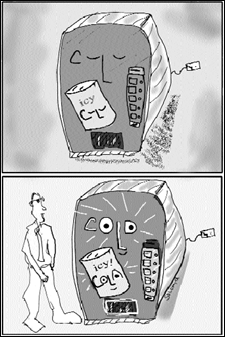Smart machines save energy:
Vending machine innovations slake thirst for savings

The vending machines in Holyoke Center won’t pour your soda for you, but they know you’re there.
The machines aren’t equipped with a new kind of artificial intelligence. Instead, they’re coupled with a new energy-saving device that tells the vending machines to turn on and off depending on whether people are in the room.
The device, called VendingMiser, was initially installed by Holyoke Center building manager Sharon Lembo and assistant building manager Camille Staco in a single sixth-floor vending machine during a trial run that began last May. By August, the device proved successful enough that the program was extended to other vending machines in Holyoke Center, according to Harvard Planning and Real Estate’s (HPRE) Sustainable Buildings Program Coordinator Elizabeth Cordero.
Vending machines use about 3,468 kilowatt-hours (kWh) of electricity annually, compared with between 450 and 800 kWh for a regular household refrigerator. That means it costs roughly $381 to operate one machine for a year. Generating that electricity results in 2.26 tons of carbon dioxide being released into the atmosphere.
With the VendingMiser, electricity consumption is cut in half, to 1,716 kWh, with resulting cuts in the electric consumption and carbon dioxide generation. The vending machine program is part of an overall effort by HPRE to save energy in its buildings. Larry McNeil, a facilities engineer with HPRE, said energy efficiency programs last year in just four buildings resulted in $200,000 in energy savings, plus an additional $200,000 energy company rebate for efficiency programs. Most of those savings came from lighting efficiency programs.
McNeil said he plans to talk about this and other energy-saving programs with other facilities personnel across the University. With more participation, he said, the savings could really add up.
“HPRE has done a lot of work on energy efficiency. We’ve gotten a lot of savings,” McNeil said.

The device works by essentially coupling an on/off switch with a motion sensor. The sensor is put on the wall above the vending machine and, when it hasn’t detected any motion for 15 minutes, shuts off the vending machine’s compressor, lights, and other electronics. This saves energy by shutting the machine off at night and during weekends, when the buildings are largely unoccupied.
“[The program] takes a machine we all take for granted – a vending machine, which is a huge energy hog – and allows us to have our convenient cold drinks with much less harm to the environment,” Cordero said.




